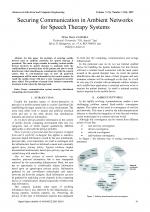| 2/2007 - 10 |
Securing Communication in Ambient Networks for Speech Therapy SystemsZAHARIA, M. H. |
| Extra paper information in |
| Click to see author's profile in |
| Download PDF |
Author keywords
communication system security, distributed computing, microcontrollers
References keywords
References keywords will be displayed on the next page reload.
About this article
Date of Publication: 2007-11-03
Volume 7, Issue 2, Year 2007, On page(s): 41 - 44
ISSN: 1582-7445, e-ISSN: 1844-7600
Digital Object Identifier: 10.4316/AECE.2007.02010
Web of Science Accession Number: 000259903400010
Abstract
One of the most present issues of computer wireless networks is the security. Comparing with their wired counterpart, the wireless networks not only accentuate some of the well-known security vulnerabilities but they are subject of new and specific ones. Among the existing wireless networks the ad hoc ones are the most exposed to attacks and collusions due to the absence of any centralized control. The most efficient way to ensure the communication secrecy, inclusively for ad hoc wireless networks, is the cryptography. From many reasons, following from specific operating conditions, the employment of asymmetric key techniques and Public Key Infrastructure is not a realistic choice. In the networks with a large number of nodes, as wireless sensor networks, a large number of secret keys are involved in order to ensure the communication secrecy. While dynamicity is one of the essential features of mobile wireless networks, when nodes may leave or join the network and in the absence of a centralized control entity, the management of secret keys is crucial. The paper presents the main aspects of mobile wireless networks security and focuses on the key management issue in ad-hoc wireless networks.In this paper the problem of securing mobile devices used in ambient networks for speech therapy is presented. The main target consists in making various mobile devices involved in speech therapy to maintain both the confidentiality of personal data of the patient and also to avoid interference when simultaneous communicate with the control center. Due to non-technical type of user all password management will be made automatic by the control system. As result the mobile device will have a user transparent security layer added. The problem of people from isolated community treatment is also solved by this approach. |
| References | | | Cited By «-- Click to see who has cited this paper |
On-line references are not available - see the PDF file if available.
Faculty of Electrical Engineering and Computer Science
Stefan cel Mare University of Suceava, Romania
All rights reserved: Advances in Electrical and Computer Engineering is a registered trademark of the Stefan cel Mare University of Suceava. No part of this publication may be reproduced, stored in a retrieval system, photocopied, recorded or archived, without the written permission from the Editor. When authors submit their papers for publication, they agree that the copyright for their article be transferred to the Faculty of Electrical Engineering and Computer Science, Stefan cel Mare University of Suceava, Romania, if and only if the articles are accepted for publication. The copyright covers the exclusive rights to reproduce and distribute the article, including reprints and translations.
Permission for other use: The copyright owner's consent does not extend to copying for general distribution, for promotion, for creating new works, or for resale. Specific written permission must be obtained from the Editor for such copying. Direct linking to files hosted on this website is strictly prohibited.
Disclaimer: Whilst every effort is made by the publishers and editorial board to see that no inaccurate or misleading data, opinions or statements appear in this journal, they wish to make it clear that all information and opinions formulated in the articles, as well as linguistic accuracy, are the sole responsibility of the author.



